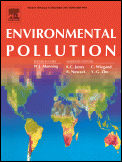Environmental Pollution 162
Overview of new articles on POPs in a new issue of the Environmental Pollution journal.
Selected articles
PAH diagnostic ratios for the identification of pollution emission sources
Pages 110-119
Marek Tobiszewski, Jacek Namieśnik
- PAH diagnostic ratios may identify pollution coming from petroleum spills, fuel combustion and coal or biomass burning. They are sensitive to changes during PAHs environmental fate processes. Some diagnostic ratios are of limited value due to fast photodegradation of one of the compounds.
Long-term persistence of polychlorinated dibenzo-p-dioxins and dibenzofurans in air, soil and sediment around an abandoned pentachlorophenol factory in China
Pages 138-143
Cheng Li, Minghui Zheng, Bing Zhang, Lirong Gao, Lidan Liu, Xin Zhou, Xiaodong Ma, Ke Xiao
- PCDD/Fs were investigated in various environmental compartments surrounding an abandoned pentachlorophenol (PCP) factory. High levels of PCDD/F contamination were found in ambient air, soils and the sediments around this factory. PCDD/F homologue profiles were consistent with PCDD/Fs in technical product of PCP. PCDD/Fs in this historical contaminated site pose a long-term impact on surrounding environment.
Polybrominated diphenyl ethers and decabromodiphenylethane in sediments from twelve lakes in China
Pages 262-268
Fengchang Wu, Jianyang Guo, Hong Chang, Haiqing Liao, Xiaoli Zhao, Bixian Mai, Baoshan Xing
- We revealed the history input of PBDEs and DBDPE into 12 lakes, including lakes from remote areas of China. High levels of PBDEs were found in the eastern and southwestern lakes. High DBDPE/BDE-209 ratios were found in sediments from the eastern lakes.
Regional variation and possible sources of brominated contaminants in breast milk from Japan
Pages 269-274
Yukiko Fujii, Yoshiko Ito, Kouji H. Harada, Toshiaki Hitomi, Akio Koizumi, Koichi Haraguchi
- In this study, we detected brominated organic contaminants in Japanese breast milk. Naturally produced brominated organic contaminants were also detected. Northern and southern Japan showed regional differences in these contaminants. Exposure to the contaminants is suggested to arise from different specific sources.
Freely dissolved PBDEs in water and porewater of an urban estuary
Pages 287-293
Victoria P. Sacks, Rainer Lohmann
- First detection of freely dissolved PBDEs in Narragansett Bay using passive PE samplers. Low dissolved concentrations (<3 pg/L) consistent with other methods that correct for DOC. Urban signal is apparent in Narragansett Bay, with higher concentrations of PBDEs closer to urban center. Environmental gradients suggest surface water and sediments are both sources of low molecular weight PBDE 8. Higher MW PBDEs were more abundant in deeper water, suggesting different transport pathway.
Dechlorination ofp,p′-DDTs coupled with sulfate reduction by novel sulfate-reducing bacteriumClostridiumsp. BXM
Pages 303-310
Peng Bao, Zheng-Yi Hu, Xin-Jun Wang, Jian Chen, Yu-Xin Ba, Jing Hua, Chun-You Zhu, Min Zhong, Chun-Yan Wu
- Non-dsrABSRBClostridiumsp. BXM was isolated from a paddy soil. lostridiumsp. BXM could utilize thiosulfate and sulfate as electron acceptor. The SRB-produced RSC represented abiotic DDT-dechlorination. The dechlorination was RSC/sulfate amount dependent.
Betaproteobacteria dominance and diversity shifts in the bacterial community of a PAH-contaminated soil exposed to phenanthrene
Pages 345-353
Florence Martin, Stéphane Torelli, Denis Le Paslier, Agnès Barbance, Fabrice Martin-Laurent, David Bru, Roberto Geremia, Gérard Blake, Yves Jouanneau
- We explored PAH-degrading bacteria on a chronically polluted site by stable isotope probing. Betaproteobacteria appeared as the main phenanthrene degraders in soil. Most soil PAH degraders were poorly related to bacteria isolated so far. Diversity shifts occurred in the community of degraders when the PAH became less available.
Brominated flame retardants in three terrestrial passerine birds from South China: Geographical pattern and implication for potential sources
Pages 381-388
Yu-xin Sun, Xiao-jun Luo, Ling Mo, Qiang Zhang, Jiang-ping Wu, She-jun Chen, Fa-sheng Zou, Bi-xian Mai
- The highest ∑PBDEs and PBB 153 concentrations were found in the e-waste area. The highest DBDPE level was observed in the urban area. PBDE congener profiles were found to be depended on bird species and sampling sites. Positive correlations were found between δ15N values and BFR concentrations.
DNA-damage effect of polycyclic aromatic hydrocarbons from urban area, evaluated in lung fibroblast cultures
Pages 430-438
Elba Calesso Teixeira, Daniel Pra, Daniele Idalgo, João Antonio Pêgas Henriques, Flavio Wiegand
- Cell line V79 was used to assess the effect of PAHs in PM2.5and PM10from urban area. Temperature showed a significant seasonal variation with the level of DNA damage. PAHs with higher molecular weight contributed to higher DNA damage levels.
20.1.2012





